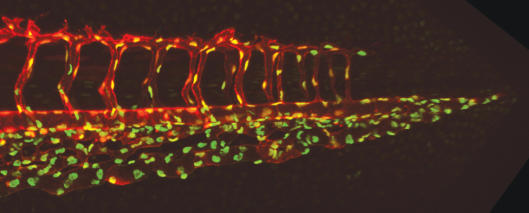Mechanisms of artery formation

During angiogenesis, new blood vessels form by sprouting out of vessels which already exist and then forming a network. This is important not only during the development of an organism but also for example when wounds heal. After completion of angiogenesis, the new vessels are defined, becoming either arteries, which pump the blood away from the heart, or veins, which transport it back there. But how does the organism monitor the correct formation of blood vessels, to make sure they do not proliferate in an uncontrolled fashion, leading to disturbed blood circulation?
Researchers at the Cells-in-Motion Cluster of Excellence at the University of Münster and at the Max Planck Institute for Molecular Biomedicine have found out, using zebrafish, that the Notch signalling pathway is responsible for proper arterial development. Notch is a protein which binds to a certain molecule on the surface of a cell, thus triggering a series of consecutive signals. The Notch signalling pathway had already been implicated in controlling angiogenesis. It was also known that it plays a role in the formation of arteries. “But the two consecutive processes were always observed separately from each other,” says Dr. Arndt Siekmann, team leader at the Cluster of Excellence. He and his colleagues discovered that there is a direct connection between the sprouting of the blood vessels and the formation of the arteries.
At the same time, the working group led by CiM team leader Prof. Ralf Adams – also from the Max Planck Institute for Molecular Biomedicine – was able to demonstrate the existence of similar mechanisms in the retina of mice. The results of their work have appeared back to back in the current issue of the “Nature Cell Biology” journal.
- All the details of the publication by the research team led by Prof. Ralf Adams (press release issued by the Max Planck Institute for Molecular Biomedicine)
All the details of the publication by the research team led by Dr. Arndt Siekmann
What exactly happens during angiogenesis? When new blood vessels form, the endothelial cells which constitute the inner wall of the vessels have to find their proper place. For this purpose, there is a so-called tip cell at the tip of every sprouting vessel which sets the direction. A second set of endothelial cells – the stalk cells – follow. The researchers discovered that the chemokine receptor cxcr4a plays an important role in this. Chemokine receptors are proteins on the surface of cells which link themselves to small signalling proteins and thus influence in which direction cells are moving. In this way, cxcr4a shows the tip cells the correct way, so that they can ultimately link up and form a functioning blood vessel system. The researchers were able to show that the Notch protein is responsible for activating the expression of chemokine receptors in tip cells and thereby influencing endothelial cells to develop into mature arteries. What the study also found is that when a sufficient number of arteries has been formed, Notch reduces the expression of the chemokine receptor and no more vessels sprout. In contrast to arteries, Notch appears to play no part in the formation of veins.
The researchers studied these processes by looking at zebrafish – which do not have the dll4 gene, which is responsible for Notch activation. The time-lapse images in a living organism showed that without proper Notch pathway activation, an excessive number of endothelial cells was formed. As a result, the new vessel system branched strongly, the cells were not able to migrate properly, and there was a subsequent increase of venous blood vessels at the expense of arteries.
Making use of endothelial cells in culture provided by the team led by Prof. Hans-Joachim Schnittler, likewise a CiM team leader and a specialist in endothelial cells, the researchers were able to further corroborate their results. This collaboration arose from an interdisciplinary research project being funded by the Cluster of Excellence.
“Our results show that the Notch signalling pathway and the formation of arteries also play a role in the process of angiogenesis,” says Arndt Siekmann. The findings from this basic research might also be of importance for disease related studies. When tumours occur, for example, new tissue forms from blood vessels in an uncontrolled fashion. The newly gained knowledge might in the future help to find new approaches to treatments, for example in stopping the unhealthy growth of arteries and other blood vessels.
Original Publication:
Hasan SS, Tsaryk R, Lange M, Wisniewski L, Moore JC, Lawson ND, Wojciechowska K, Schnittler H, Siekmann AF. Endothelial Notch signalling limits angiogenesis via control of artery formation. Nat Cell Biol 2017;19: 928-940; DOI 10.1038/nbc3574. Abstract

